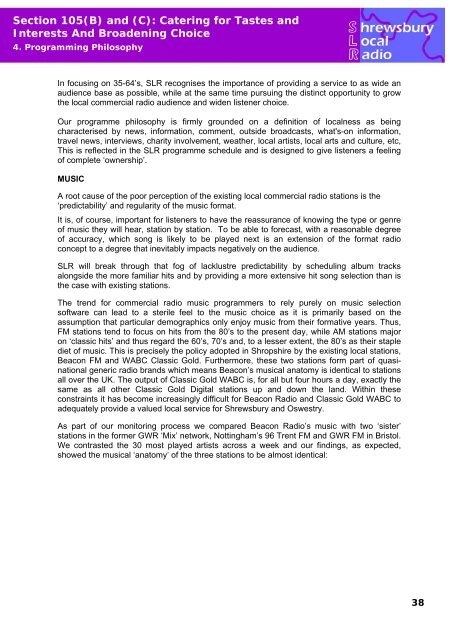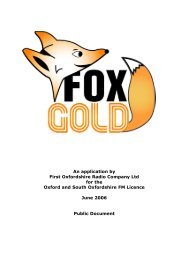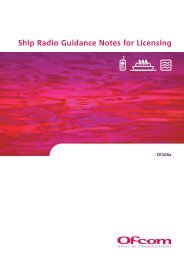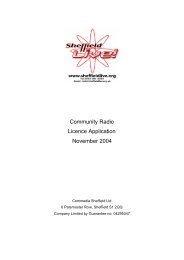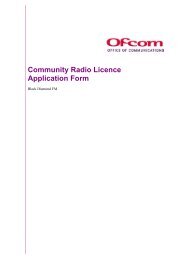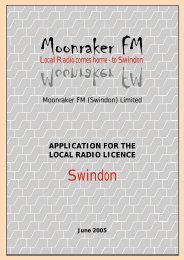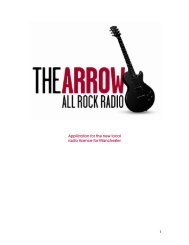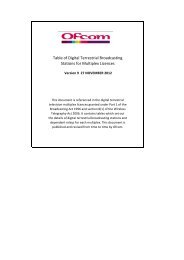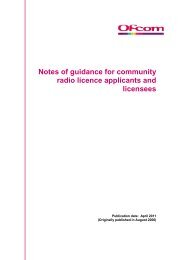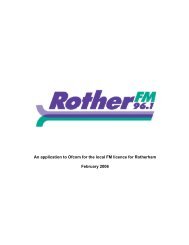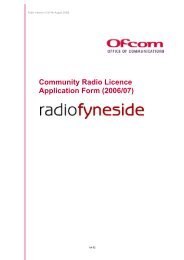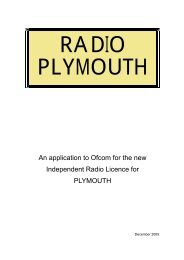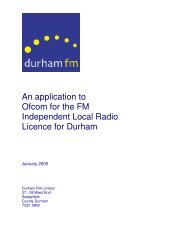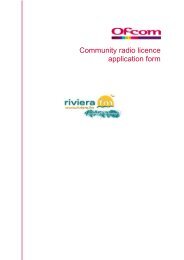SLR - Ofcom Licensing
SLR - Ofcom Licensing
SLR - Ofcom Licensing
Create successful ePaper yourself
Turn your PDF publications into a flip-book with our unique Google optimized e-Paper software.
Section 105(B) and (C): Catering for Tastes and<br />
Interests And Broadening Choice<br />
4. Programming Philosophy<br />
In focusing on 35-64’s, <strong>SLR</strong> recognises the importance of providing a service to as wide an<br />
audience base as possible, while at the same time pursuing the distinct opportunity to grow<br />
the local commercial radio audience and widen listener choice.<br />
Our programme philosophy is firmly grounded on a definition of localness as being<br />
characterised by news, information, comment, outside broadcasts, what's-on information,<br />
travel news, interviews, charity involvement, weather, local artists, local arts and culture, etc,<br />
This is reflected in the <strong>SLR</strong> programme schedule and is designed to give listeners a feeling<br />
of complete ‘ownership’.<br />
MUSIC<br />
A root cause of the poor perception of the existing local commercial radio stations is the<br />
‘predictability’ and regularity of the music format.<br />
It is, of course, important for listeners to have the reassurance of knowing the type or genre<br />
of music they will hear, station by station. To be able to forecast, with a reasonable degree<br />
of accuracy, which song is likely to be played next is an extension of the format radio<br />
concept to a degree that inevitably impacts negatively on the audience.<br />
<strong>SLR</strong> will break through that fog of lacklustre predictability by scheduling album tracks<br />
alongside the more familiar hits and by providing a more extensive hit song selection than is<br />
the case with existing stations.<br />
The trend for commercial radio music programmers to rely purely on music selection<br />
software can lead to a sterile feel to the music choice as it is primarily based on the<br />
assumption that particular demographics only enjoy music from their formative years. Thus,<br />
FM stations tend to focus on hits from the 80’s to the present day, while AM stations major<br />
on ‘classic hits’ and thus regard the 60’s, 70’s and, to a lesser extent, the 80’s as their staple<br />
diet of music. This is precisely the policy adopted in Shropshire by the existing local stations,<br />
Beacon FM and WABC Classic Gold. Furthermore, these two stations form part of quasinational<br />
generic radio brands which means Beacon’s musical anatomy is identical to stations<br />
all over the UK. The output of Classic Gold WABC is, for all but four hours a day, exactly the<br />
same as all other Classic Gold Digital stations up and down the land. Within these<br />
constraints it has become increasingly difficult for Beacon Radio and Classic Gold WABC to<br />
adequately provide a valued local service for Shrewsbury and Oswestry.<br />
As part of our monitoring process we compared Beacon Radio’s music with two ‘sister’<br />
stations in the former GWR ‘Mix’ network, Nottingham’s 96 Trent FM and GWR FM in Bristol.<br />
We contrasted the 30 most played artists across a week and our findings, as expected,<br />
showed the musical ‘anatomy’ of the three stations to be almost identical:<br />
38


